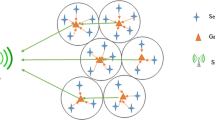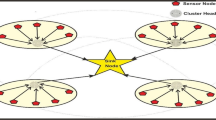Abstract
Energy consumption is one of the important factor of Wireless Sensor Networks (WSN). It has much attention in many fields. From recent studies, it is observed that energy consumption in WSN is challenging task as the energy is limited resource. This energy is needed for sensor nodes operation. In order to maximize the network lifetime, energy consumption should be mitigated. In cluster based WSN, cluster head i.e., the leader of cluster performs various activities, such as data collection from its member nodes, data aggregation and data exchange with base station. Hence, load balancing in WSNs is one of the challenging task to maximize network lifetime. In order to address this problem, in this paper, Shuffled Complex Evolution (SCE) algorithm is used. A novel fitness function is also designed to evaluate fitness of solutions produced by SCE algorithm. In SCE, the solutions with best and worst fitness value exchange their information to produce new off-spring. We have simulated proposed load balancing algorithm along with other state-of-the-art load balancing algorithms, namely Node Local Density Load Balancing, Score Based Load Balancing, Simple Genetic Algorithm based load balancing, Novel Genetic Algorithm based Load Balancing. It is observed from experimental results that proposed load balancing algorithm outperforms state-of-the-art load balancing algorithms in terms of load balancing, energy consumption, execution time, number of sensor nodes and number of heavy loaded sensor nodes.












Similar content being viewed by others
References
Anastasi, G., Conti, M., Di Francesco, M., & Passarella, A. (2009). Energy conservation in wireless sensor networks: A survey. Ad Hoc Networks, 7(3), 537–568.
Bala, A., & Sharma, A. K. (2015). A comparative study of modified crossover operators. In: Image Information Processing (ICIIP), 2015 Third International Conference on, pp. 281–284. IEEE
Baranidharan, B., & Santhi, B. (2016). Ducf: Distributed load balancing unequal clustering in wireless sensor networks using fuzzy approach. Applied Soft Computing, 40, 495–506.
Bari, A., Wazed, S., Jaekel, A., & Bandyopadhyay, S. (2009). A genetic algorithm based approach for energy efficient routing in two-tiered sensor networks. Ad Hoc Networks, 7(4), 665–676.
Chong, C. Y., & Kumar, S. P. (2003). Sensor networks: Evolution, opportunities, and challenges. Proceedings of the IEEE, 91(8), 1247–1256.
Duan, Q., Gupta, V. K., & Sorooshian, S. (1993). Shuffled complex evolution approach for effective and efficient global minimization. Journal of Optimization Theory and Applications, 76(3), 501–521.
Gattani, V. S., & Jafri, S. H. (2016). Data collection using score based load balancing algorithm in wireless sensor networks. In: Computing Technologies and Intelligent Data Engineering (ICCTIDE), International Conference on, pp. 1–3. IEEE
Gherbi, C., Aliouat, Z., & Benmohammed, M. (2016). An adaptive clustering approach to dynamic load balancing and energy efficiency in wireless sensor networks. Energy, 114, 647–662.
Gopalakrishnan, K., & Kim, S. (2010). Global optimization of pavement structural parameters during back-calculation using hybrid shuffled complex evolution algorithm. Journal of Computing in Civil Engineering, 24(5), 441–451.
Heinzelman, W. B., Chandrakasan, A. P., & Balakrishnan, H. (2002). An application-specific protocol architecture for wireless microsensor networks. IEEE Transactions on Wireless Communications, 1(4), 660–670.
Kim, H. Y., & Kim, J. (2017). An energy-efficient balancing scheme in wireless sensor networks. Wireless Personal Communications, 94(1), 17–29.
Kuila, P., Gupta, S. K., & Jana, P. K. (2013). A novel evolutionary approach for load balanced clustering problem for wireless sensor networks. Swarm and Evolutionary Computation, 12, 48–56.
Kuila, P., & Jana, P. K. (2011). Improved load balanced clustering algorithm for wireless sensor networks. In: International Conference on Advanced Computing, Networking and Security, pp. 399–404. London: Springer
Kuila, P., & Jana, P. K. (2012). Energy efficient load-balanced clustering algorithm for wireless sensor networks. Procedia Technology, 6, 771–777.
Kumar, V., & Kumar, S. (2016). Energy balanced position-based routing for lifetime maximization of wireless sensor networks. Ad Hoc Networks, 52, 117–129.
Lattanzi, E., Regini, E., Acquaviva, A., & Bogliolo, A. (2007). Energetic sustainability of routing algorithms for energy-harvesting wireless sensor networks. Computer Communications, 30(14), 2976–2986.
Low, C. P., Fang, C., Ng, J. M., & Ang, Y. H. (2008). Efficient load-balanced clustering algorithms for wireless sensor networks. Computer Communications, 31(4), 750–759.
Mittal, N., Singh, U., & Sohi, B. S. (2017). A novel energy efficient stable clustering approach for wireless sensor networks. Wireless Personal Communications
Raghavendra, C. S., Sivalingam, K. M., & Znati, T. (2006). Wireless sensor networks. London: Springer.
Rosset, V., Paulo, M. A., Cespedes, J. G., & Nascimento, M. C. (2017). Enhancing the reliability on data delivery and energy efficiency by combining swarm intelligence and community detection in large-scale wsns. Expert Systems with Applications, 78, 89–102.
Tang, J., Hao, B., & Sen, A. (2006). Relay node placement in large scale wireless sensor networks. Computer Communications, 29(4), 490–501.
Xu, Y., Heidemann, J., & Estrin, D. (2001). Geography-informed energy conservation for ad hoc routing. In: Proceedings of the 7th Annual International Conference on Mobile Computing and Networking, pp. 70–84. ACM
Zhang, J., & Yang, T. (2013). Clustering model based on node local density load balancing of wireless sensor network. In: Emerging Intelligent Data and Web Technologies (EIDWT), 2013 Fourth International Conference on, pp. 273–276. IEEE
Zhao, F., Zhang, J., Zhang, C., & Wang, J. (2015). An improved shuffled complex evolution algorithm with sequence mapping mechanism for job shop scheduling problems. Expert Systems with Applications, 42(8), 3953–3966.
Author information
Authors and Affiliations
Corresponding author
Rights and permissions
About this article
Cite this article
Edla, D.R., Lipare, A. & Cheruku, R. Shuffled Complex Evolution Approach for Load Balancing of Gateways in Wireless Sensor Networks. Wireless Pers Commun 98, 3455–3476 (2018). https://doi.org/10.1007/s11277-017-5024-3
Published:
Issue Date:
DOI: https://doi.org/10.1007/s11277-017-5024-3




